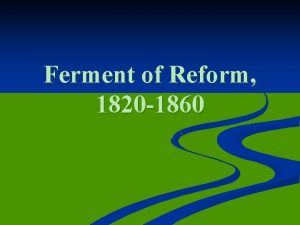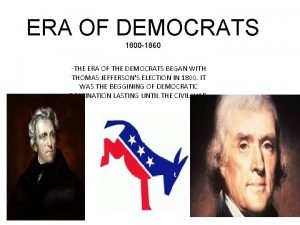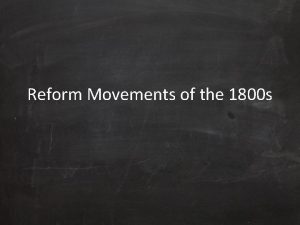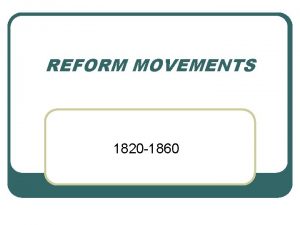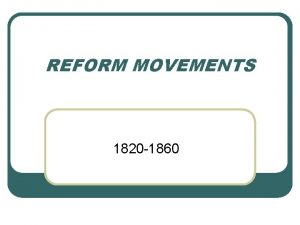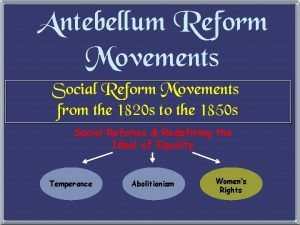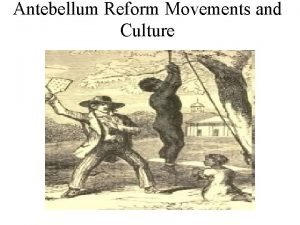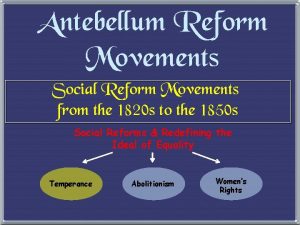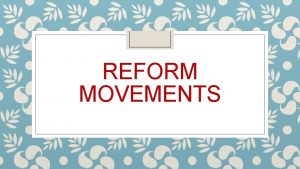Reform Movements 1800 1860 Some well into the








- Slides: 8

Reform Movements 1800 -1860… Some well into the 20 th century.

Quote In France, I had almost always seen the spirit of religion and the spirit of freedom pursuing courses diametrically opposed to each other; but in America, I found that they were intimately united, and that they reigned in common over the same country… Religion was the foremost of the political institutions of the United States. ▪ -- Alexis de Tocqueville, 1832

I. Religious Sources of Reform A. Second Great Awakening--religious revivals among Protestants. (already covered) B. New religious groups formed as instruments of reform 1. Utopian societies created in reaction to urban growth and industrialization. Emphasis on community and withdrawal from society 2. Shakers--socially radical. Abolished families, practiced celibacy and full equality between sexes. 3. Mormons--Organized by Joseph Smith in 1830 as a cooperative theocracy with himself as the Prophet. Because of persecution, Smith and his followers moved from New York to Ohio to Missouri to Illinois, where he was murdered by opponents. Succeeded by Brigham Young, who led migration to Utah. - We will go more in detail later.

II. Non-Religious Utopian Communities A. New Harmony, Illinois. 1825. Socialist center founded by Robert Owen to be self-sufficient and existing without currency. Failed after several years. B. Brook Farm Experiment. Transcendentalist in orientation, rejecting society's standards and Enlightenment thought, emphasizing individualism and the mysteries of nature. Famous contributors: Emerson, Thoreau, Hawthorne, Melville.

III. Other Areas of Early Social Reform A. Temperance--religious basis in violation of the Sabbath. Movement moved from moderation to abstinence to prohibition in its goals. Led by women but supported by factory owners who had massive absenteeism on Mondays. B. Education--compulsory education in every state by 1860. Led by Horace Mann, who secularized the curriculum and made it more practical to train citizens. C. Women's Rights--women were considered so inferior to men that they were not allowed to obtain higher education, vote, or control their own property 1. Grimke sisters (1838) began with abolitionism, then turned to attacking the subordinate women. Similarities to position of slaves noted. position of 2. Seneca Falls Statement (1848)--statement of women's mistreatment by men. 3. Improvement made possible by: a) Democratic spirit of Jacksonian period, which caused reformers to call for women's suffrage b) Industrial revolution demonstrated to women that they could enter occupations c) Reform movements, where women could crusade equally with men.

III. Other Areas of Early Social Reform continued D. Abolitionism 1. American Colonization Society formed (1816) to gradually emancipate blacks and settle them in Africa. (Henry Clay shows up again!) 2. Abolitionism rose in the 1830 s with an emphasis on racial equality. Intent on freeing, then educating blacks. a) William Lloyd Garrison The Liberator demanded immediate abolition. b) Theodore Weld worked for gradual emancipation through religious conversion. Used Oberlin College as training ground for abolitionists c) Organized abolitionists smuggled on average 2, 000 slaves a year out of the South to Canada and deluged Congress with petitions despite the gag rule (1836) which forbade the discussion of slavery in Congress. d) David Walker- Most famous speech/writing: “Appeal in Four Articles” e) Fredrick Jackson Turner- Many Famous speeches/writings, Editor of the North Star

III. Other Areas of Early Social Reform continued E. Humane Treatment of Individuals 1) Dorothea Dix investigated and reported treatment of insane and led to creation of humane institutions 2) Legal code reforms a) Reduction in crimes punishable by death b) Abolishing of public hangings in many states c) Abandoning flogging and other cruel punishments 3) Prison reform--rehabilitation of criminals attempted to counter the tendency of prisons to create more hardened criminals. Work seen as way to reform criminals.

Transcendentalism ▪ Transcendentalism- divinity pervades all nature and humanity, and its members held progressive views on feminism and communal living. ▪ Most notable transcendentalist: Henry David Thoreau, Ralph Waldo Emerson, and Margaret Fuller (crosses over with Women’s Rights movement” ▪ Focus on Thoreau – Famous book, “Walden”- discusses nature and man’s relation to nature in depth with a focus on living a good and simple life within natural surroundings – Famous essay, “Civil Disobedience”. Wrote by Thoreau when he was protesting the U. S. government’s war with Mexico. Thoreau refused to pay his taxes because they go to helping the government wage in his view an unjust war. ▪ Thoreau argues that man has a right and duty to be disobedient (without being violent) against unjust actions.
 Chapter 12 religion romanticism and reform
Chapter 12 religion romanticism and reform American reform movements between 1820 and 1860
American reform movements between 1820 and 1860 American romanticism 1800 to 1860 worksheet answers
American romanticism 1800 to 1860 worksheet answers American romanticism 1800 to 1860
American romanticism 1800 to 1860 Rationalism vs romanticism
Rationalism vs romanticism Whig party beliefs
Whig party beliefs American romanticism 1800 to 1860 worksheet answers
American romanticism 1800 to 1860 worksheet answers Reform movements def
Reform movements def Reform movements 1800s
Reform movements 1800s

